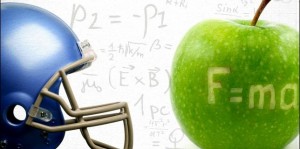
Newton’s Football, the Science Behind America’s Game studies football through the lens of physics and mathematics. Authors Allen St. John and Ainissa Ramirez, in collaboration with some of the most famous scientists of this century, provide a unique view on the most popular Sunday family-bonding event. St. John is a best-selling author whose talents complement those of Ramirez, a previous material science professor. Together, they have created an accessible and enjoyable scientific novel. Still, in their efforts to increase scientific accessibility, the authors come dangerously close to over-simplifying their explanations.


As the title suggests, Newton’s Football, describes properties of physics such as gravity and spin in order to explain ball movement and other phenomena in football. The authors introduce mathematician Steve Wolfram, a scholar famous mostly for the creation of Wolfram Alpha, a helpful mathematical website, and Mathematica, a programming language often used to model functions. Wolfram’s connection with the authors is twofold: he is a mathematician well versed in three-dimensional modeling and highly interested in teaching science in an enjoyable fashion. To the reader, Newton’s Football, the Science Behind America’s Game gains additional credibility because of its mainstream scientific references, like Wolfram. Readers are thus able to put their trust in reputable members of the scientific community as opposed to the relatively unknown authors.
Because of their early established credibility, Allen St. John and Ainissa Ramirez quickly and comfortably dive into the hard science behind football relatively early. Each section alternates between an anecdote on the football field and a scientific explanation for the phenomenon. This structure creates an easy-to-follow and captivating novel for any football fan.
Newton’s Football maintains an easy pace suitable for any reader. For example, the novel often includes the history of football in the introductions to chapters. St. John and Ramirez discuss the creation of the actual ball, which is made from pigskin! These odd facts are always drawn back into the conceptual model of football. The making and shape of the football is connected to the direction of its movement. However, because of its easy pace, Newton’s Football might be common knowledge for some advanced scientists. A heavily physics based or mathematics-based texts would be more appropriate for their background.
Most high school level physics classes address parabolic motion of an object. St. John and Ramirez do not wade deeper than this high school physics level explanation. In their effort to create an accessible novel, the authors somewhat dulled down their message: football can be understood using science. Rather, Newton’s Football seems to suggest that these two areas are incompatible because the science has been dulled down.
St. John and Ramirez straddled the disciplinary line in their book, Newton’s Football, the Science Behind America’s Game. Though the authors blend these two areas together, there are often a sharp contrasts between purely scientific and purely sports vocabulary. For example St. John refers to the football as a Wilson “Duke” but also describes the “prolate spheroid” shape of the ball. Of course, if given a chance, Newton’s Football can be understood by readers without a background in science or football. The novel is a worthwhile read for any individual interested in the intersection between science and sports.
